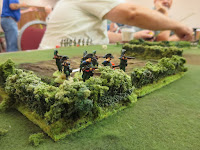Friday, our club gathered for our August game night. Given the time of year, the turnout was light...
...but spirited. Above, some of the usual suspects. Numbers notwithstanding, there were three excellent games on the slate. Micheal B had a WWI Bolt Action game, Greg S had a unique 1799 French Rev in Italy Chosen Men skirmish game, and Charlie (author of Napoleon's Rules of War) offered a Peninsular Napoleonic game based on the Battle of Barossa, 1811. Given that I was involved in the last, I can't say much about the other two, but can share some eye candy. They were a treat to see and seemed very well received and run, from what I overheard. In the below, I would encourage you to clix pix for BIG PIX to see more...
WWI Bolt Action Game
Michael orienting the players
1799 Chosen Men Game
Greg, in the blue shirt, the game master
Napoleon's Rules of War Battle of Barrosa, 1811, Game
This is the game that I participated in. I'm not up on the Peninsula, but Charlie informed us that the Battle of Barrosa was basically an ambush--a column of Spanish and British got p0unced upon by the French from two directions. Being a game fellow (aka not bright), I took up the side of the ambushed, and just to be sporting, I choose the Spaniards.
(Above) Charlie orienting the players before the game. At right, Warren looks on. He would be my compadre on the allied side, running the British. Pete (seated), listens intently while licking his lips in Gallic anticipation of what is to come...
...The allies started in columns within their respective areas, marked by red string. My bully Spaniards are at the head (to the left) and the British are coming up, forming our right: a brave sight! ...
...The French deploy. On the extreme French right, AJ, of AJ's Wargaming Blog, spots his troops. Meanwhile, on the opposite side of the table, Pete (seated) and Bob O (no head) put down the main French force. The French, Spaniards, and British, each had an exhaustion level--accumulated when batteries or battalions went "Poof!" The French had to crack both the Spaniards and the British. We had to crack the French or avoid the above. Simple, no?
You will note in the above pictures a large forest to the front of the Spaniards...
...this would figure prominently in my BRILLIANT plan! Warren and the British would anchor our right, whilst I, Don Meanderer, General of the Spaniards, would block the road with successive lines of infantry and guns in order to thwart Gen d Division AJ, and I would push a brigade of light troops into the forest in a "telling maneuver" that would stymie any attempt by the French to skulk through that way.
What ensued was something of a blur. I think the following series will convey the results...
...(above) my Spaniards positioned on the road: ready to make the French pay...
...meanwhile, my four battalions of Spanish light infantry shake into open order and move into the forest...
..the combined effect of these BRILLIANT schemes...
...meanwhile, on our right, Warren and the British were having an equally BRILLIANT day...
...and so, despite an ingenious plan, we got stomped.
However, getting out at the end of the week, gathering with like minded fellows, pushing toy soldiers, this all worked out as planned. Thanks to Charlie, Michael, and Greg for putting on another fine set of games for the club. To Warren, thanks for sharing in the adversity. And to our cordial opponents for the evening, AJ, Pete, and Bob: wait'll next time!
Excelsior!























































